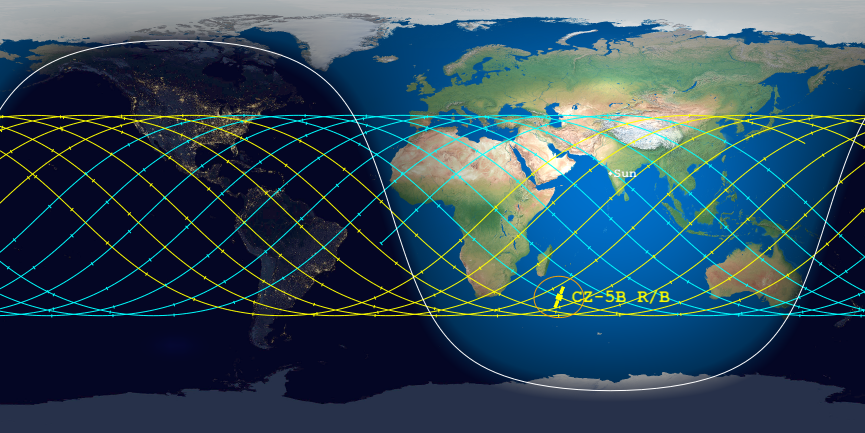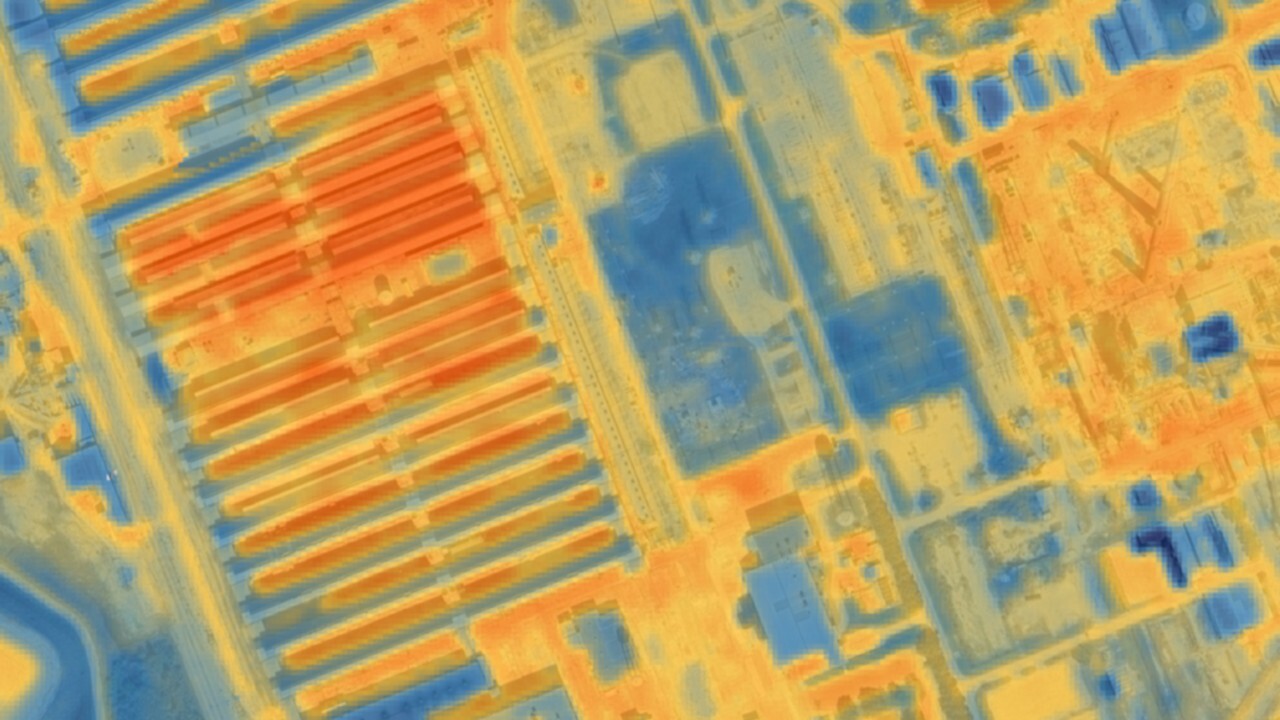A huge Chinese rocket booster is falling from space, but don't worry. It likely won't hit you.
You have almost nothing to worry about, a debris expert says.
A massive Chinese rocket booster will plummet out of space this weekend, but you shouldn't fret much about it falling on you. You've got almost nothing to worry about, a space debris expert said.
The core stage of a Long March 5B rocket, which launched China's Tianhe space station module last week, is making an uncontrolled fall back to Earth and that, naturally, raised concerns with some. However, in an interview with Space.com, Jonathan McDowell, an astrophysicist at the Harvard-Smithsonian Center for Astrophysics, the typical risk of an individual being hit is "one in many billions."
That said, there is a small risk that pieces of the 23-ton (21 metric tons) vehicle will hit Earth somewhere that is populated, and it's not the first time China has had a huge rocket fall back to Earth recently.
Related: How to track China's falling rocket booster online
"The first time for a rocket of this type was a year ago, and the core stage re-entered over Africa," McDowell told Space.com. "These 10-meter [30-foot] long metal rods slammed into the roofs of people's houses. So the fact that happened, [the] first time out, tells you that the risk of property damage — at least — is not tiny, because it happened. We were lucky that there were no casualties."
The core stage's orbit places it over populated areas ranging from the United States to Chile to Australia. But it's most likely that the pieces will plop in the ocean, which covers about 70 percent of Earth. Land areas make up the rest of Earth's surface and only a portion of those areas are inhabited, McDowell noted. (Chinese foreign ministry spokesperson Wang Wenbin has said the country is tracking the fall and that the risk to inhabited areas is "extremely low," according to Reuters.)
Naturally, however, people want more details and tracking information on what's going to happen. In updates to media and on Twitter, McDowell has been updating his followers with such information using re-entry predictions from the U.S. Space Command at Space-Track.org, from the Aerospace Corporation's website and the European Space Agency Space Situational Awareness program.
Breaking space news, the latest updates on rocket launches, skywatching events and more!
All these entities are mostly in agreement with their predictions about reentry, with minor variations, McDowell noted. He also is running his own orbital calculations about where Long March 5B's core stage is in orbit based on the U.S. Space Command information, but said he doesn't attempt re-entry predictions on his own because, as he put it, it is "just too darn hard."
McDowell cited several factors that play into how to predict the fall of the rocket core. The first is to remove any thinking that it is coming in like a space shuttle or spacecraft, he said, meaning it won't come in at an angle or almost vertically. Rather, he said, the stage is "belly surfing the atmosphere" as its orbit lessens in altitude around Earth.
Related: The biggest spacecraft to fall uncontrolled from space
Another factor is the sheer speed at which the stage is traveling in orbit, which is roughly 18,000 mph (28,000 kph). "So, if you guess wrong by an hour, concerning when it's going to reenter, then you've guessed wrong in location by 18,000 miles," McDowell said. (That's roughly six times the driving distance between the Pacific and Atlantic coasts of the United States, depending on what route you take.)
Another question is when will the core stage get low enough in Earth's atmosphere to burn up. "That depends a little bit on the materials it's made of," McDowell said, adding that it depends "more on how it's tumbling." The stage could be doing anything from tumbling end over end to plowing into the atmosphere like an arrow or even coming in sideways and catching the full brunt of atmospheric heating.
"Also, the density of the upper atmosphere changes from day to day," he said. "There's outer space weather, which is as hard to predict as ordinary weather. In particular, solar activity — X-rays from the sun — affects the structure of the outer atmosphere … in a way that we just don't know how to predict."
While this uncertainty shrinks somewhat as the rocket gets closer to Earth, we will only know the exact fall time of the rocket pieces after the fact. If they fall on an empty, or uninhabited area, Space Force will be the first to know about it because their missile early warning satellites will spot the heat from the falling pieces in infrared telescopes, McDowell said. "But, because they keep that data secret, historically, it's taken a few hours, like three or so hours, for that data and making its way through the bureaucracy [to become] public information."
Related: Space Command is tracking China's rocket, but won't shoot it down
If chunks of the 5B rocket fall onto a populated area, however, "Twitter and Instagram will light up with cell phone videos about the pieces of metal that fell from the sky," McDowell said. In the extremely unlikely event you come across space debris, he added, don't touch it and call the police or local authorities. Under space law, China technically has rights to get the rocket chunks back, and they also may be called upon to fulfill Outer Space Law liability concerns if there is property or other damage.
McDowell added that it's unusual for huge pieces of space debris to fall to Earth these days, particularly after international condemnation that followed two incidents: the Soviet Kosmos 954 nuclear satellite that spewed radiation-laden pieces across the Canadian Arctic in 1977 (for which Canada eventually recovered cleanup compensation from the Soviet Union) and the NASA Skylab space station's uncontrolled atmosphere plummet in 1979 that saw some pieces slam into Australia, luckily with no casualties.
"Every few months, there's some small piece of space debris that gets found on the ground, but we haven't had this kind of 20-ton object re-entering uncontrolled for 30 years, until the Chinese started their 5B launches," McDowell said.
McDowell pointed to newer launching standards by the international community that he urged China to follow, as they have avoided larger reentry events like the Skylab or Kosmos incidents. (The major uncontrolled falls these last few decades have been largely composed of dead spacecraft).
Instead of allowing a big rocket stage to go into orbit, companies and countries typically shut down the rocket a few seconds early so that the fall back to Earth lands the piece(s) in a predictable location. If the rocket is sending a payload into orbit, McDowell added, "they add engines to the thing … and make those little engines do the last few miles an hour to get it into orbit … it's disappointing that they didn't do that."
McDowell added that the rocket debris problem, which he characterized as fairly minimal, is distinct from the fast-growing problem of orbital debris. The last few years saw a couple of satellite collisions, some near-misses, and fast-growing fleets of satellites going into orbit for broadband Internet, like SpaceX's Starlink.
"That's an increasing problem, that the number of close misses between satellites is going way up," McDowell said. "That's a big challenge for the world space community to try and do something more organized about traffic control. It's going to be a big topic in the years to come."
Follow Elizabeth Howell on Twitter @howellspace. Follow us on Twitter @Spacedotcom and on Facebook.

Elizabeth Howell (she/her), Ph.D., was a staff writer in the spaceflight channel between 2022 and 2024 specializing in Canadian space news. She was contributing writer for Space.com for 10 years from 2012 to 2024. Elizabeth's reporting includes multiple exclusives with the White House, leading world coverage about a lost-and-found space tomato on the International Space Station, witnessing five human spaceflight launches on two continents, flying parabolic, working inside a spacesuit, and participating in a simulated Mars mission. Her latest book, "Why Am I Taller?" (ECW Press, 2022) is co-written with astronaut Dave Williams.



